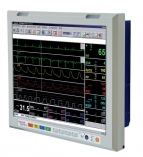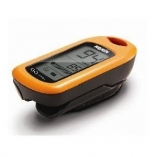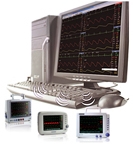Reports and News
Vitals Monitor
By definition, a vitals monitor can be something as simple as assessing someone's pulse rate by placing a finger on one of their major arteries and counting the number of times their heart is beating per minute or observing their respirations to determine how many breaths they are taking during a specific time period. A modern vital sign monitor, however, is a medical device that, once properly attached to a subject, performs these two functions automatically. It can also monitor several other body functions, including temperature and blood pressure.
One of the earliest examples of a vital sign monitor, invented in 1881 by an Austrian doctor named Samuel Siegfried Karl Ritter von Basch, is the sphygmomanometer or blood pressure cuff. This device, with which most people are likely familiar, consists of an inflatable cuff that, when pumped up on a patient's arm above the elbow, restricts blood flow through the arm's major artery. Used in conjunction with a stethoscope, a sphygmomanometer tells at what pressure blood first begins to flow and again at what pressure it flows unimpeded, known as the diastolic and systolic pressures, respectively. These are the two numbers given in a blood pressure reading, such as 80/120 (eighty over one-twenty).
Today's vitals monitor does quite a bit more than that of a simple blood pressure cuff, although measuring blood pressure is still one of its main functions. When a patient is attached to a modern-day vital sign monitor, a great deal of information about a subject is transmitted by means of series of graphs and numbers on a screen, occurring along a time axis, providing health professionals with a continuing measurement of heart rate, respiratory rate, temperature and blood pressure. Modern equipment is capable of sending this information to a monitoring network and of printing out a hard copy of the details for further study. It6 may also be able to sound an alarm when any of the vital signs being monitored fall outside of normal parameters, alerting hospital staff, for example, of patient problems.
Digitalization of the current day vitals monitor has allowed it to be much more compact than the older analog versions. The smaller size enables is to be transportable and easily carried into the field, making it an indispensible item of equipment for ambulance personnel as well as Emergency Medical Technicians (EMTs) manning fire department vehicles. Even organizations with limited funding are able to purchase refurbished patient monitors for use on their EMS vehicles, giving first responders a live-saving capability not before available. Refurbished patient monitors can be obtained for a fraction of the cost of new equipment, yet they still retain the same capabilities of the newer, most expensive units.
Another popular use for refurbished patient monitors is in the home or the workplace. With their portability and demonstrated life-saving history, an affordable, used unit can easily be placed in a home of an individual with ongoing medical problems or at a jobsite where injuries frequently occur.
Medical Monitors
14
Jun
With the skyrocketing costs of medical equipment today, how can you provide your patients the attentive care they need while al... Read More
Wireless Vital Signs Monitor
14
Jun
Medical professionals in the market for a wireless vital signs monitor and refurbished patient monitors can choose from a varie... Read More
Hospital Vital Signs Monitor
14
Jun
Hospital Vital Signs MonitorVitalsignmonitorsforsale.com provides one the best ... Read More





